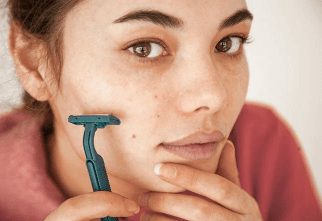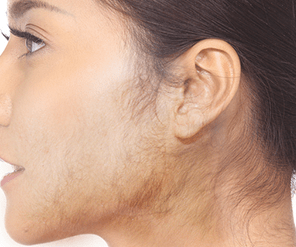Hirsutism:
Hirsutism is a condition in women that results in excessive growth of dark or coarse hair in a male-like pattern — face, chest and back. Hirsutism can result from excess male hormones, called androgens. This may occur with certain medical conditions. It may also be inherited.
Hirsutism results in excessive amounts of stiff and pigmented hair on body areas where men typically grow hair, including the face, chest and back.
Hirsutism is treated with medication. Hair can also be removed with electrolysis or laser therapy.
Symptoms
Hirsutism is stiff or dark body hair, appearing on the body where women don’t commonly have hair — primarily the face, chest, lower abdomen, inner thighs and back. People have widely varying opinions on what’s considered excessive. When high androgen levels cause hirsutism, other signs might develop over time, a process called virilization. Signs of virilization might include:
- Deepening voice
- Balding
- Acne
- Decreased breast size
- Increased muscle mass
- Enlargement of the clitoris
Causes
- Polycystic ovary syndrome (PCOS):This condition, which often begins with puberty, causes an imbalance of sex hormones. Over years, PCOS may slowly result in excess hair growth, irregular periods, obesity, infertility and sometimes multiple cysts on the ovaries.
- Cushing syndrome:This occurs when your body is exposed to high levels of the hormone cortisol. It can develop from your adrenal glands making too much cortisol or from taking medications such as prednisone over a long period.
- Congenital adrenal hyperplasia:This inherited condition is characterized by abnormal production of steroid hormones, including cortisol and androgen, by your adrenal glands.
- Tumors:Rarely, an androgen-secreting tumor in the ovaries or adrenal glands can cause hirsutism.
- Medications:Some medications can cause hirsutism. These include minoxidil (Minoxidil, Rogaine); danazol, which is used to treat women with endometriosis; testosterone (Androgel, Testim); and dehydroepiandrosterone (DHEA). If your partner uses topical products containing androgens, you can be affected as well, through skin-to-skin contact.

When to See Doctor
If you think you have too much coarse hair on your face or body, talk with your doctor about treatment options.
Excess facial or body hair is often a symptom of an underlying medical problem. See your doctor for assessment if over a few months you experience severe or rapid hair growth on your face or body or signs of virilization. You may be referred to a doctor who specializes in hormone disorders (endocrinologist) or skin problems (dermatologist).
Risk Factor
- Family history.Several conditions that cause hirsutism, including congenital adrenal hyperplasia and polycystic ovary syndrome, run in families.
- Women of Mediterranean, Middle Eastern and South Asian ancestry are more likely to have more body hair with no identifiable cause than are other women.
- Being obese causes increased androgen production, which can worsen hirsutism.
Complication
- Hirsutism can be emotionally distressing. Some women feel self-conscious about having unwanted hair. Some develop depression. Also, although hirsutism doesn’t cause physical complications, the underlying cause of a hormonal imbalance can.
- If you have hirsutism and irregular periods, you might have polycystic ovary syndrome, which can inhibit fertility. Women who take certain medications to treat hirsutism should avoid pregnancy because of the risk of birth defects.
Treatment
Medications
- Oral contraceptives:Birth control pills or other hormonal contraceptives, which contain estrogen and progestin, treat hirsutism caused by androgen production. Oral contraceptives are a common treatment for hirsutism in women who don’t want to become pregnant. Possible side effects include nausea and headache.
- Anti-androgens:These types of drugs block androgens from attaching to their receptors in your body. They’re sometimes prescribed after six months on oral contraceptives if the oral contraceptives aren’t effective enough. The most commonly used anti-androgen for treating hirsutism is spironolactone (Aldactone, CaroSpir). The results are modest and take at least six months to be noticeable. Possible side effects include menstrual irregularity. Because these drugs can cause birth defects, it’s important to use contraception while taking them.
- Topical cream: Eflornithine (Vaniqa) is a prescription cream specifically for excessive facial hair in women. It’s applied directly to the affected area of your face twice a day. It helps slow new hair growth but doesn’t get rid of existing hair. It can be used with laser therapy to enhance the response.
Medical Therapy
- Laser therapy:A beam of highly concentrated light (laser) is passed over your skin to damage hair follicles and prevent hair from growing (photoepilation). You might need multiple treatments. For people whose unwanted hair is black, brown or auburn, photoepilation is usually a better option than electrolysis. Talk with your doctor about the risks and benefits of the various lasers used for this hair removal method. People with tanned or darkly pigmented skin are at increased risk of side effects from certain lasers, including a darkening or lightening of their usual skin tones, blistering, and inflammation.
- Electrolysis:This treatment involves inserting a tiny needle into each hair follicle. The needle emits a pulse of electric current to damage and eventually destroy the follicle. You might need multiple treatments. For people with naturally blond or white hair, electrolysis is a better option than laser therapy. Electrolysis is effective but can be painful. A numbing cream spread on your skin before treatment might reduce discomfort.
Home Remedies
- Plucking:Plucking is a good method to remove a few stray hairs, but is not useful for removing a large area of hair. Plucked hair usually regrows. This hair removal method may be done with tweezers, thin threads (threading) or other devices designed for this purpose.
- Shaving:Shaving is quick and inexpensive, but it needs to be repeated regularly.
- Waxing:Waxing involves applying warm wax on your skin where the unwanted hair grows. Once the wax hardens, you pull it from your skin to remove hair. Waxing removes hair from a large area quickly, but it may sting temporarily and sometimes causes skin irritation and redness.
- Depilation:Chemical depilatories are applied to the affected skin, where they dissolve hair. These products are available in a variety of forms, such as gel, cream or lotion. They may irritate the skin and cause dermatitis. You’ll need to repeat depilation regularly to maintain the effect.
- Bleaching: Bleaching lightens hair colour, making it less noticeable on people with light skin. Hair-bleaching products, which usually contain hydrogen peroxide, may cause skin irritation. Test any product you use on a small area of skin first.


